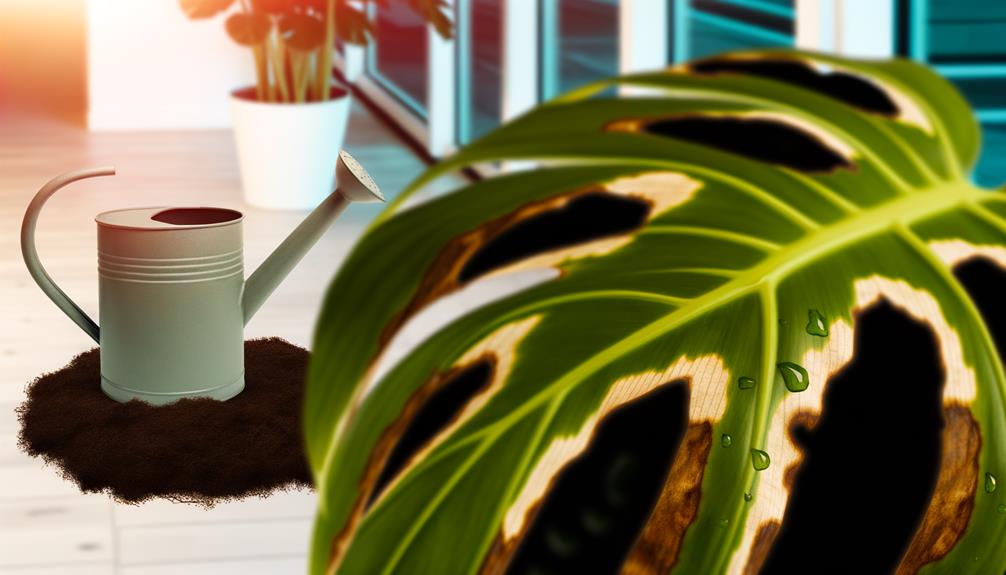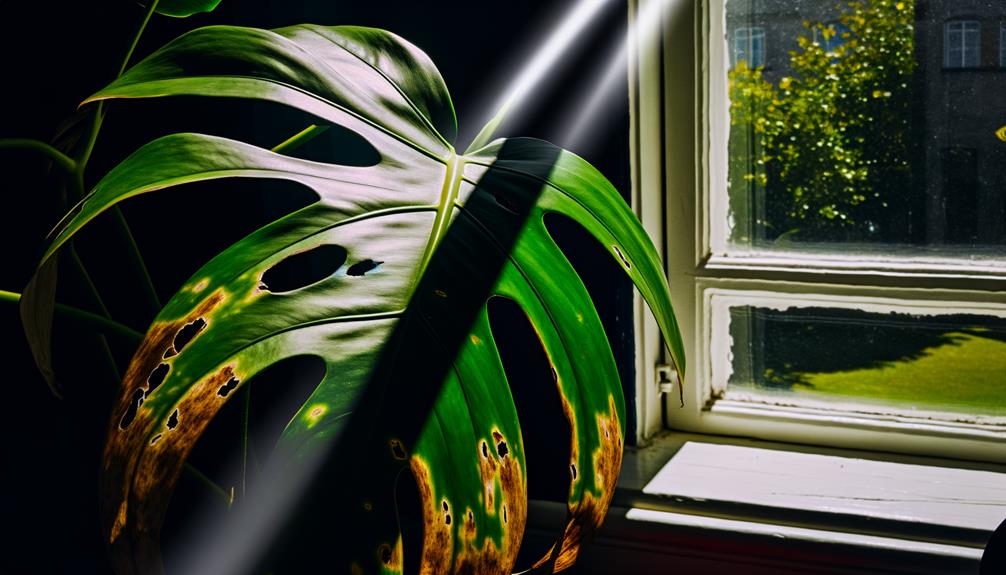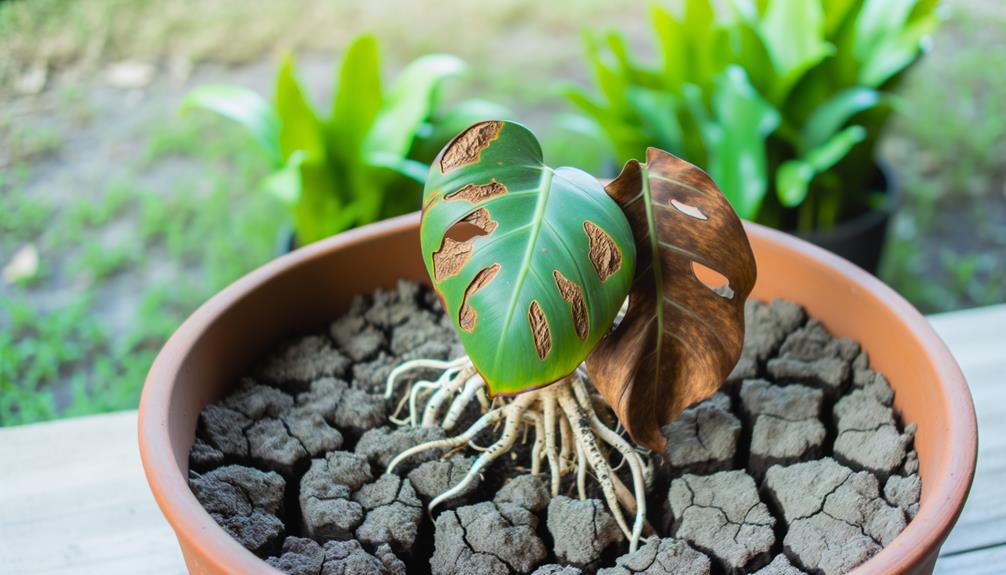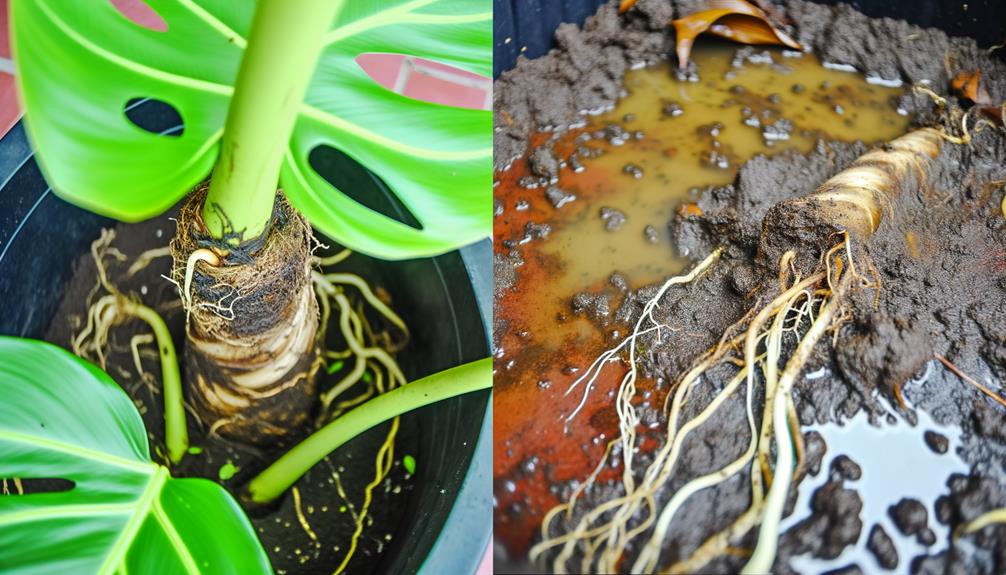Why Is My Monstera Albo Turning Brown
Your Monstera Albo is turning brown likely due to improper watering, such as overwatering, which causes root rot, or underwatering, leading to dehydration. Low humidity can also make leaves brown; maintaining 60-80% humidity is essential.
Insufficient light hinders photosynthesis, causing browning, while excessive direct sunlight burns leaves. Temperature fluctuations and poor soil drainage also stress the plant.
Additionally, inspect for pests and fungal infections, common culprits of browning leaves. Adjust watering, light conditions, and humidity for best plant health.
Continue for a detailed guide on ensuring your Monstera Albo thrives.

Key Takeaways
- Overwatering can lead to root rot, causing browning of Monstera Albo leaves.
- Low humidity levels can dehydrate leaves, leading to browning.
- Excessive direct sunlight can cause leaf burn and browning.
- Poor soil drainage can lead to root rot and browning leaves.
- Nutrient deficiencies in poor soil can result in browning foliage.
Watering Issues

Improper watering practices can stress your Monstera Albo, leading to brown, crispy leaf edges. Overwatering suffocates roots, causing root rot and hindering nutrient uptake. You should allow the top 1-2 inches of soil to dry out before watering again.
Conversely, underwatering deprives the plant of necessary moisture, resulting in desiccated leaf tissue. Check soil moisture by inserting your finger into the soil up to your first knuckle. If it feels dry, it's time to water.
Use a well-draining potting mix and a pot with drainage holes to prevent waterlogging. Ensure water reaches the root zone but avoid leaving the plant in standing water. Balanced watering promotes peak cellular function and overall plant health, mitigating browning issues.
Humidity Levels
Maintaining the best humidity range for your Monstera Albo, typically between 60-80%, is essential for preventing browning leaves. Low humidity levels can lead to common issues such as leaf dehydration and browning edges.
To increase humidity effectively, you can use methods like misting, using a humidifier, or placing the plant on a pebble tray with water.
Optimal Humidity Range
To keep your Monstera Albo thriving, maintain the humidity levels consistently between 60% and 80%. This range mimics the plant's native tropical environment, promoting ideal physiological processes such as transpiration and nutrient uptake. Utilizing a hygrometer can help you monitor these levels precisely. If your indoor air is too dry, consider using a humidifier or placing a water tray nearby.
Here's a quick reference table for maintaining humidity:
| Humidity Level (%) | Action Required |
|---|---|
| Below 60% | Use a humidifier |
| 60%-70% | Ideal, maintain current |
| 70%-80% | Optimal, minimal action |
| Above 80% | Reduce humidity, ventilate |
Maintaining this precise humidity range prevents brown leaf tips and ensures your Monstera Albo remains lush and healthy.
Common Humidity Issues
Frequently, fluctuations in humidity levels can lead to a range of issues for your Monstera Albo, such as leaf browning and stunted growth. Monstera Albo thrives in environments with consistent humidity levels, ideally between 60% and 80%.
When humidity drops below this range, the plant's leaves may lose moisture faster than the roots can replenish it, causing them to turn brown. Conversely, excessively high humidity can foster fungal diseases and root rot.
Regularly monitoring ambient humidity using a hygrometer can help you maintain ideal conditions. Sudden changes in humidity—often caused by seasonal shifts or HVAC systems—can stress the plant, impacting its overall health and vigor.
Stability in humidity levels is important for maintaining your Monstera Albo's lush appearance.
Increasing Humidity Effectively
For effectively increasing humidity levels around your Monstera Albo, consider using a humidifier to provide a consistent moisture source that mimics its natural tropical environment. Choose an ultrasonic or evaporative humidifier, which are efficient and maintain a stable moisture level. Aim for a 60-70% humidity range, as this closely replicates the plant's native habitat.
Position the humidifier near the plant, but make sure it's not directly aimed at the foliage to prevent waterlogging. Regularly monitor humidity levels with a hygrometer to make adjustments as necessary. Additionally, grouping plants together or placing a water tray with pebbles under the pot can enhance local humidity.
These methods will help maintain ideal conditions, reducing the likelihood of browning leaves.
Light Exposure

If your Monstera Albo is turning brown, you need to evaluate its light exposure.
Insufficient natural light can hinder photosynthesis, while excessive direct sunlight may cause leaf burn.
Aim for best light conditions by providing bright, indirect light to maintain healthy foliage.
Insufficient Natural Light
Insufficient natural light can lead to the browning of Monstera Albo leaves due to inadequate photosynthesis, which hinders the plant's ability to produce the energy required for healthy growth.
When your Monstera Albo doesn't receive enough light, chlorophyll production decreases, causing the leaves to lose their vibrant green color and turn brown. The plant struggles to convert light into chemical energy, leading to weakened structures and compromised cellular functions.
Place your Monstera Albo near a bright, indirect light source to make sure it gets the necessary photons for photosynthesis. Avoid dark corners or areas far from windows, as these conditions can impede growth and essentiality, ultimately resulting in browning leaves and an unhealthy plant.
Excessive Direct Sunlight
Excessive direct sunlight can scorch Monstera Albo leaves, leading to browning and cellular damage due to the intense UV radiation and heat stress. When your plant is exposed to too much light, the chlorophyll in the leaves breaks down, impairing photosynthesis and causing visible damage.
You might notice:
- Leaf discoloration: Yellowing followed by brown spots.
- Leaf curling: Edges curl as the plant tries to minimize surface area.
- Dry, brittle texture: Leaves lose moisture rapidly.
- Burnt patches: Dark, crisp areas indicate severe sunburn.
- Stem damage: Prolonged exposure can weaken stems.
High-intensity sunlight accelerates water loss, exacerbating dehydration and stress. It's crucial to monitor light levels and adjust placement to prevent further damage.
Optimal Light Conditions
To maintain your Monstera Albo in good health and prevent browning, place it in bright, indirect light where it can receive sufficient illumination without the harsh effects of direct sunlight.
Monstera Albo thrives in environments that replicate its natural habitat: the understory of tropical rainforests. Direct sunlight can cause leaf burn, resulting in brown, crispy edges. Instead, choose a location with filtered light, such as near an east-facing window or behind sheer curtains.
Guarantee that the light intensity remains consistent, as fluctuating light conditions can stress the plant. For indoor settings, artificial grow lights with a color temperature between 5000K to 6500K can supplement natural light, promoting healthy growth while preventing browning.
Regularly rotate the plant to ensure uniform light distribution.
Temperature Fluctuations
Temperature fluctuations can stress a Monstera Albo, leading to browning leaves as the plant struggles to adapt to inconsistent conditions. Sudden changes in temperature can disrupt the plant's physiological processes, causing cellular damage and impaired nutrient uptake.
To mitigate this, you should maintain a stable environment. Key factors include:
- Avoiding drafts: Keep your Monstera away from doors or windows that frequently open.
- Consistent indoor temperatures: Aim for a range between 65-80°F (18-27°C).
- Gradual adjustments: When moving plants, do it gradually to acclimate them.
- Heating and cooling devices: Position plants away from heaters or air conditioners.
- Humidity control: Guarantee relative humidity stays around 60%, as dry air can exacerbate temperature stress.
Soil Quality

Equally important for maintaining ideal temperature conditions, guaranteeing high-grade soil is essential for preventing your Monstera Albo from developing brown leaves. Best soil should be well-draining, aerated, and rich in organic matter. A mix of peat, perlite, and orchid bark can achieve this balance.
Poor soil drainage leads to waterlogged roots, causing root rot and subsequent browning. Conversely, overly sandy soils lack the necessary water retention, stressing your plant. Soil pH should remain slightly acidic to neutral, ideally between 5.5 and 7.
Regularly check soil moisture levels; the top inch should dry out before re-watering. Using a moisture meter can help maintain consistency. Proper soil quality ensures strong root health, essential for vibrant, green foliage.
Fertilizer Use
Proper fertilizer use is critical for ensuring your Monstera Albo receives the necessary nutrients to maintain healthy, vibrant foliage. Over-fertilizing or using the wrong type can lead to browning leaves due to nutrient imbalances or salt buildup in the soil.
To optimize your fertilization routine:
- Use a balanced, water-soluble fertilizer with an N-P-K ratio of 20-20-20.
- Apply fertilizer bi-monthly during the growing season (spring and summer).
- Dilute the fertilizer to half the recommended strength to avoid root burn.
- Monitor the plant's response and adjust the frequency or concentration as needed.
- Flush the soil periodically to remove excess salts.
Understanding these principles will help you maintain the health and appearance of your Monstera Albo.
Root Rot

You need to recognize root rot early by observing signs like mushy roots, a foul odor, and yellowing leaves.
Guarantee proper drainage and avoid overwatering to prevent root rot from developing.
Use well-aerated soil and inspect roots regularly to maintain plant health.
Identifying Root Rot
Often, root rot in Monstera Albo can be identified by examining the plant's roots for signs of decay, discoloration, and a mushy texture. When you suspect root rot, carefully remove the plant from its pot and inspect the root system. Healthy roots appear firm and white.
In contrast, afflicted roots will exhibit:
- Dark brown to black coloration: Signifying necrosis and tissue decay.
- Mushy consistency: Indicating the breakdown of root structure.
- Unpleasant odor: A foul smell often accompanies root rot.
- Sloughing: The outer layer of roots may easily peel away.
- Reduced root mass: Noticeable shrinkage due to decayed roots.
Preventing Root Rot
To effectively prevent root rot in Monstera Albo, make certain the plant's soil remains well-drained and avoid overwatering.
Utilize a potting mix that integrates materials like perlite, orchid bark, and peat moss to enhance aeration and drainage.
Ensure the pot has sufficient drainage holes to prevent water accumulation.
Water the plant only when the top 2-3 inches of soil are dry, and avoid letting the pot sit in excess water.
Regularly inspect the roots for signs of rot, such as a foul odor or mushy texture.
If you notice any issues, trim the affected roots and repot the plant in fresh, sterile soil.
Maintaining these practices will markedly reduce the risk of root rot in your Monstera Albo.
Pest Infestations
Pest infestations, particularly from spider mites and aphids, can cause Monstera Albo leaves to turn brown by sucking the sap and weakening the plant's overall health. These pests reduce the plant's ability to photosynthesize effectively.
To identify and manage these pests, you should:
- Inspect: Regularly examine leaves for tiny insects or webbing.
- Isolate: Quarantine affected plants to prevent spreading.
- Clean: Wipe leaves with a damp cloth to remove pests manually.
- Treat: Apply insecticidal soap or neem oil solution.
- Monitor: Continuously check for signs of re-infestation.
Fungal Infections

While pest infestations can cause browning in Monstera Albo leaves, fungal infections are another significant culprit that compromise the plant's health. You might notice spots or patches turning brown, often accompanied by a fuzzy or powdery texture.
Common fungal pathogens like Fusarium, Pythium, and Phytophthora thrive in overly moist conditions. They invade through the roots and spread systemically, disrupting nutrient uptake and causing leaf discoloration. To diagnose fungal infections, check the soil for excessive moisture and observe the roots for rot.
Treating involves reducing watering frequency, improving drainage, and applying fungicides specifically formulated for ornamental plants. Maintaining proper humidity and air circulation can also prevent fungal spores from settling and proliferating on your Monstera Albo.
Mechanical Damage
Mechanical damage to Monstera Albo leaves, whether from physical trauma, handling errors, or environmental factors, can cause browning and tissue necrosis that compromise the plant's aesthetic and physiological health. When you handle your plant or it experiences accidental bumps, the leaves can develop brown, necrotic areas. This damage disrupts the leaf's vascular system and impairs photosynthesis.
To minimize mechanical damage, consider the following:
- Avoid overcrowding: Guarantee adequate space around your plant to prevent accidental knocks.
- Careful handling: Support leaves when moving or repotting.
- Prune with caution: Use sharp, sterile tools to avoid tearing.
- Protect from pets: Keep curious animals away.
- Stable environment: Prevent exposure to strong winds or heavy rainfall indoors.
Age of Leaves

With age, Monstera Albo leaves naturally undergo senescence, leading to browning and eventual leaf drop as part of the plant's life cycle. Senescence is a programmed process where cells deteriorate and die to make space for new growth.
As leaves age, they lose chlorophyll, causing a decline in photosynthetic efficiency. This results in the appearance of brown spots, particularly at the edges and tips. It's a normal physiological response and doesn't indicate poor plant health.
Monitoring leaf age can help you distinguish between natural aging and other issues like nutrient deficiencies or environmental stressors.
To promote overall plant health, regularly remove senescent leaves, ensuring resources are directed towards younger, healthier foliage.
Conclusion
In short, if your Monstera Albo is turning brown, it's basically screaming for assistance! You're likely drowning it, baking it, or neglecting its delicate needs.
Check its watering schedule, boost humidity, balance light exposure, maintain a stable temperature, and guarantee nutrient-rich, well-draining soil.
Don't forget to inspect for pests and fungal issues. Even the slightest mechanical damage or natural leaf aging can exaggerate the problem.
Get it right, or your prized plant will become a botanical disaster!






